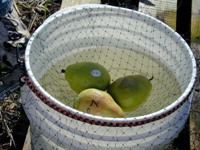Phytophthora Baiting in Irrigation Water
go.ncsu.edu/readext?669355
en Español / em Português
El inglés es el idioma de control de esta página. En la medida en que haya algún conflicto entre la traducción al inglés y la traducción, el inglés prevalece.
Al hacer clic en el enlace de traducción se activa un servicio de traducción gratuito para convertir la página al español. Al igual que con cualquier traducción por Internet, la conversión no es sensible al contexto y puede que no traduzca el texto en su significado original. NC State Extension no garantiza la exactitud del texto traducido. Por favor, tenga en cuenta que algunas aplicaciones y/o servicios pueden no funcionar como se espera cuando se traducen.
Português
Inglês é o idioma de controle desta página. Na medida que haja algum conflito entre o texto original em Inglês e a tradução, o Inglês prevalece.
Ao clicar no link de tradução, um serviço gratuito de tradução será ativado para converter a página para o Português. Como em qualquer tradução pela internet, a conversão não é sensivel ao contexto e pode não ocorrer a tradução para o significado orginal. O serviço de Extensão da Carolina do Norte (NC State Extension) não garante a exatidão do texto traduzido. Por favor, observe que algumas funções ou serviços podem não funcionar como esperado após a tradução.
English
English is the controlling language of this page. To the extent there is any conflict between the English text and the translation, English controls.
Clicking on the translation link activates a free translation service to convert the page to Spanish. As with any Internet translation, the conversion is not context-sensitive and may not translate the text to its original meaning. NC State Extension does not guarantee the accuracy of the translated text. Please note that some applications and/or services may not function as expected when translated.
Collapse ▲Detection of Phytophthora in Water Supplies
Commercial growers who suspect that Phytophthora spores may be present in the irrigation water supply for their greenhouse or nursery may test their water supply with the pear baiting method.
Please call ahead at 919-515-3619 before deploying pear baits, to discuss the timing of sample submission.
When submitting sample information in our online database, select “Ponds; Lakes; Impounded waters” as the host. Diagnostic fees apply. A set of 3 pears representing a single water source is considered as one sample.
Preparation of pear baits
- Purchase pears directly from wholesalers such that the pears are coming directly out of cold storage. It is important that green, rock-hard pears be used.
- Just before use, wash pears gently in warm, soapy, mild dish detergent to remove any fungicide residues. Rinse pears in clean water and blot dry with paper towels.
In ponds supplying a greenhouse or nursery
- Supplies: Inner tube, (3/16″ or 1/4″) poly rope, and citrus-type mesh bag.
- Place 5-7 pears in citrus bag. You won’t be submitting all of those (see below), but you need extras just in case.
- Attach bag in center of inner tube with rope straps so that it is free to settle into the water.
- If turtles are in the pond construct a cage of wire mesh hardware cloth to protect pears from being eaten.
- Attach 100 ft. of poly rope on either side of inner tube. Place tube and bag in water at one corner of the pond, then have two people walk in opposite directions away from corner so that the tube is floating out in the pond.
- Secure rope ends to stakes on bank so that tube will remain fairly stationary.
- After 3 days, retrieve tubes.
- Pack and ship pears as detailed below.
In the greenhouse
- Clean, sanitize with bleach, and thoroughly rinse a large bucket or opaque storage bin.
- Add about 5 gals of water to the bucket, combining water from two or three different points in the greenhouse where water is piped in. Water should be about 4-5 inches deep.
- Float green, rock hard pears on water, about 3 pears/bin for 3 days.
- After 3 days, remove pears from water.
Packing pears for shipment
- For each water source/location, choose 3 pears at random to constitute the sample.
- Place each pear in a sandwich-sized recloseable bag.
- Put bagged pears from each location in a larger plastic bag and label accordingly.
- Pack in a sturdy shipping container with plenty of padding to reduce bruising of fruit during shipment.
- Call the PDIC at 919-515-3619 before shipping, so we can be sure to have the necessary supplies ready.
- Ship on a Monday, Tuesday, or Wednesday for next-day delivery. See our shipping page for addresses.
 |
 |
| Pears suspended in top of sample water just so fruit are covered. | Pears after baiting period. |


